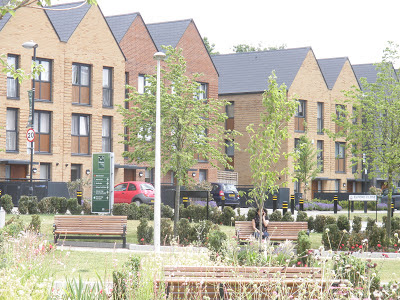Monday, 8 July 2013
At Kidbrooke Village
Estate regeneration - mainly, knocking down and starting again - is taking place, or planned, on a massive scale across many of the biggest postwar public housing estates all over London.
Last week, developers Berkeley organised a morning of talks and tours at Kidbrooke in Greenwich, where the Ferrier Estate, built forty years ago by the GLC and now in the hands of Greenwich Council, is being demolished and turned into a mixed tenure development, at about twice the density of the old housing. That ratio appears to be typical for such schemes, the 50% of housing for sale helping to pay for the 50% of affordable housing, reprovided in the same total amount as before.
Work has been going on for four years now - the first phases, of an admirably high standard of design and finish, are occupied, and the last of the old buildings were being flattened in front of our eyes.
The Ferrier, very isolated from surrounding areas, had become notorious for physical and social problems as early as the late 1980s, but when the first tenants had moved in less than 20 years earlier, they loved it (or at least there is film of tenants saying they loved it) - as was often the case with such housing.
In today's redevelopments, there is much emphasis on social as well as environmental and economic sustainability, and Berkeley are promoting studies of how this can be achieved in developments of this kind - undertaken here by Social Life, an offshoot of the Young Foundation.
Much work in sociology concerns the built environment, but one can't help suspecting that connections between the different professions and disciplines generally remain poor, and studies such as this one rare. Former LCC architect John Partridge's account of his involvement in the design of the seminal housing estate at Roehampton - another estate, much of which is listed, now due to be regenerated - mentions the involvement of a sociologist on the LCC staff in the 1950s as if that were not a particularly unusual thing. It would, one suspects, be unusual now, yet one can't help wondering how much the social consequences of the redevelopment of many of these estates is being dealt with at a deeper level than that of a wing and a prayer.
Typically, such places were cut off from their surroundings and quite different in almost every way: appearance, tenure, social mix etc. Now they are being reintegrated with their surrounding physically, and monocultural tenures are being replaced by more mixed forms. But the enterprise could still be described as 'experimental' - a term often used in the past as a criticism of failed housing schemes, such as Robin Hood Gardens, though in fact there was seldom any research or any findings. But if things were properly monitored, that surely would be a good thing. The new Kidbrooke Village, with good looking buildings and the lavish landscape that Berkeley have learnt makes good marketing sense, feels a long way away from the bleak housing it has replaced. One hopes that studies such as those being carried out by Social Life will continue through the remaining twenty years or so of rebuilding that remains.
Subscribe to:
Post Comments (Atom)





No comments:
Post a Comment